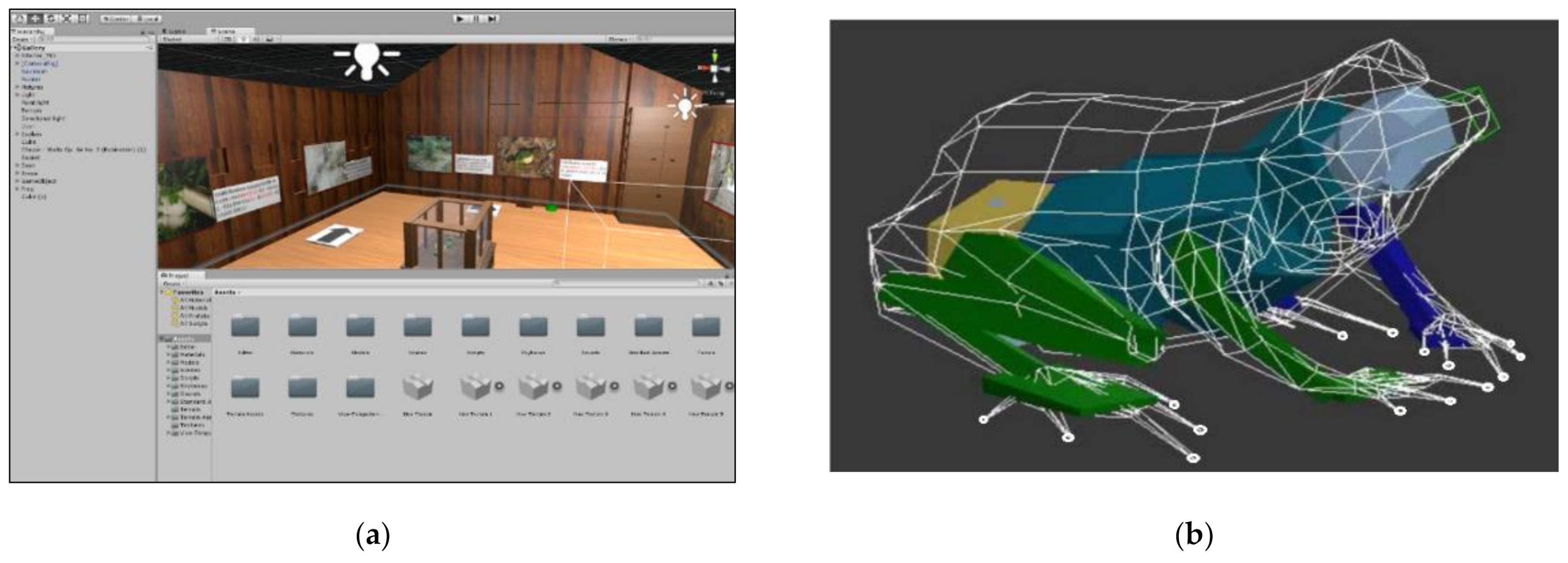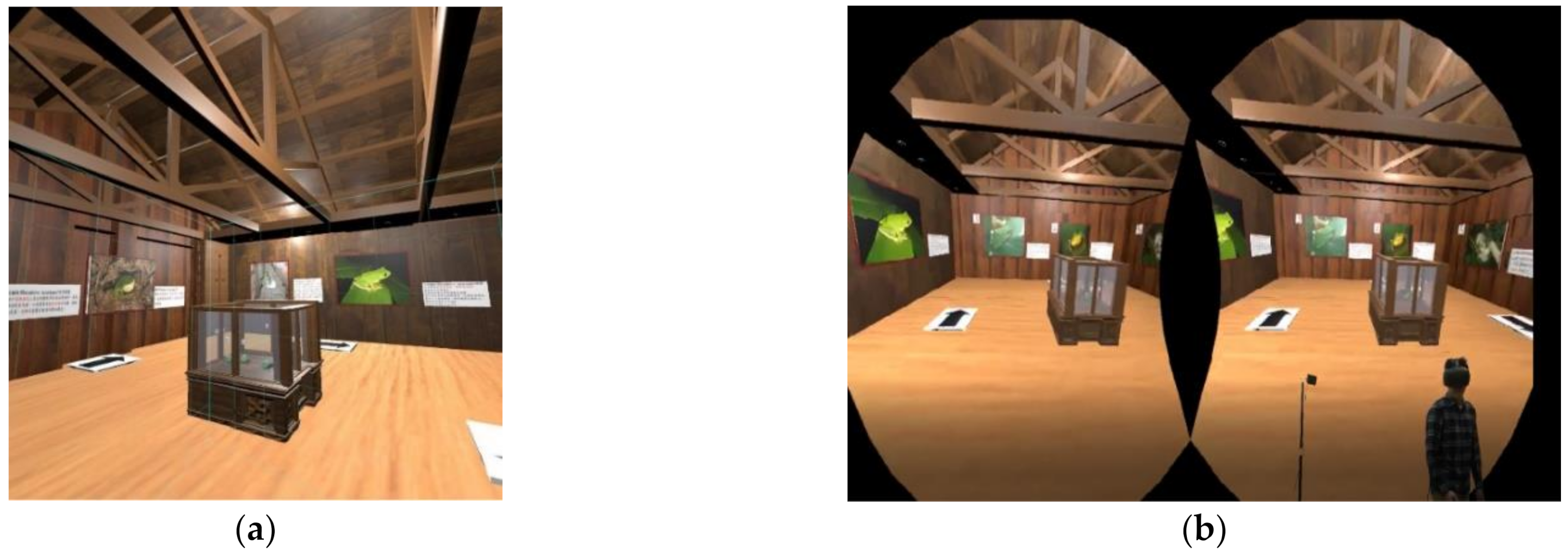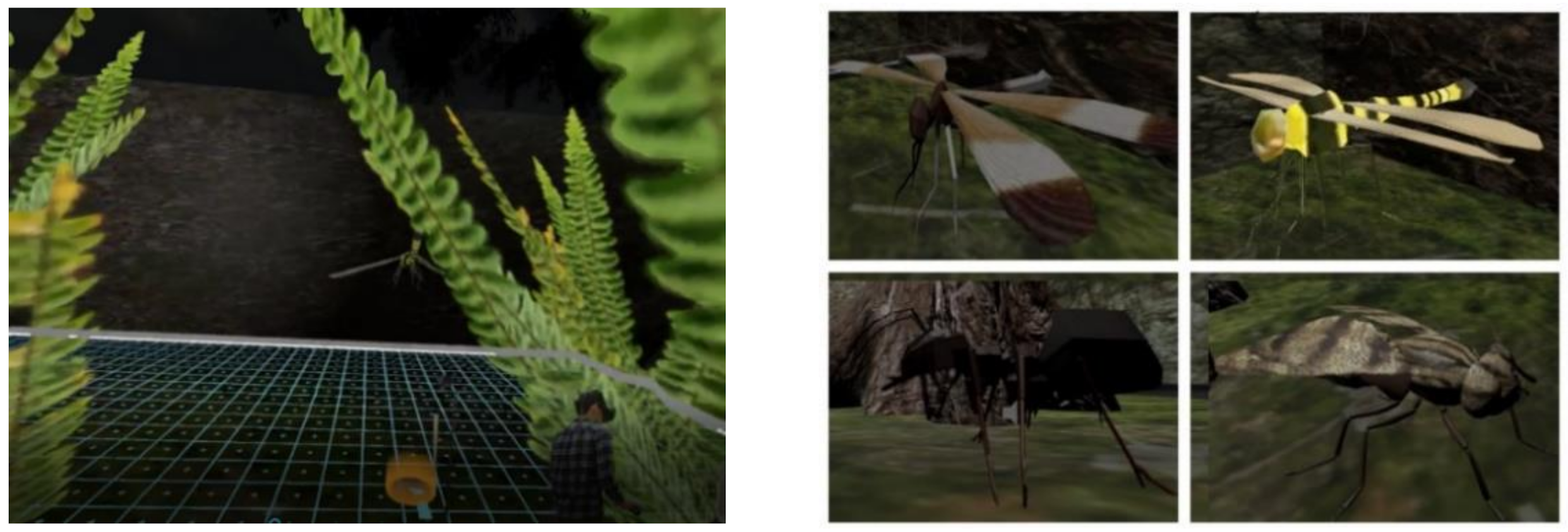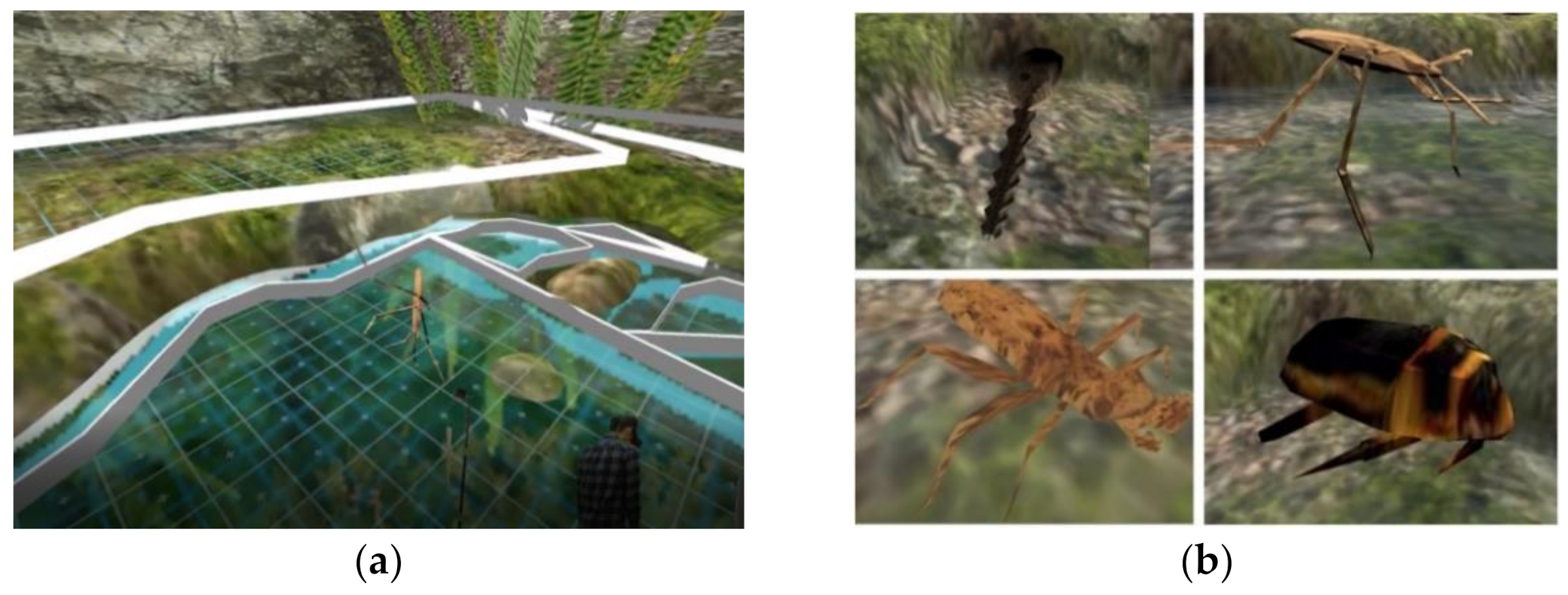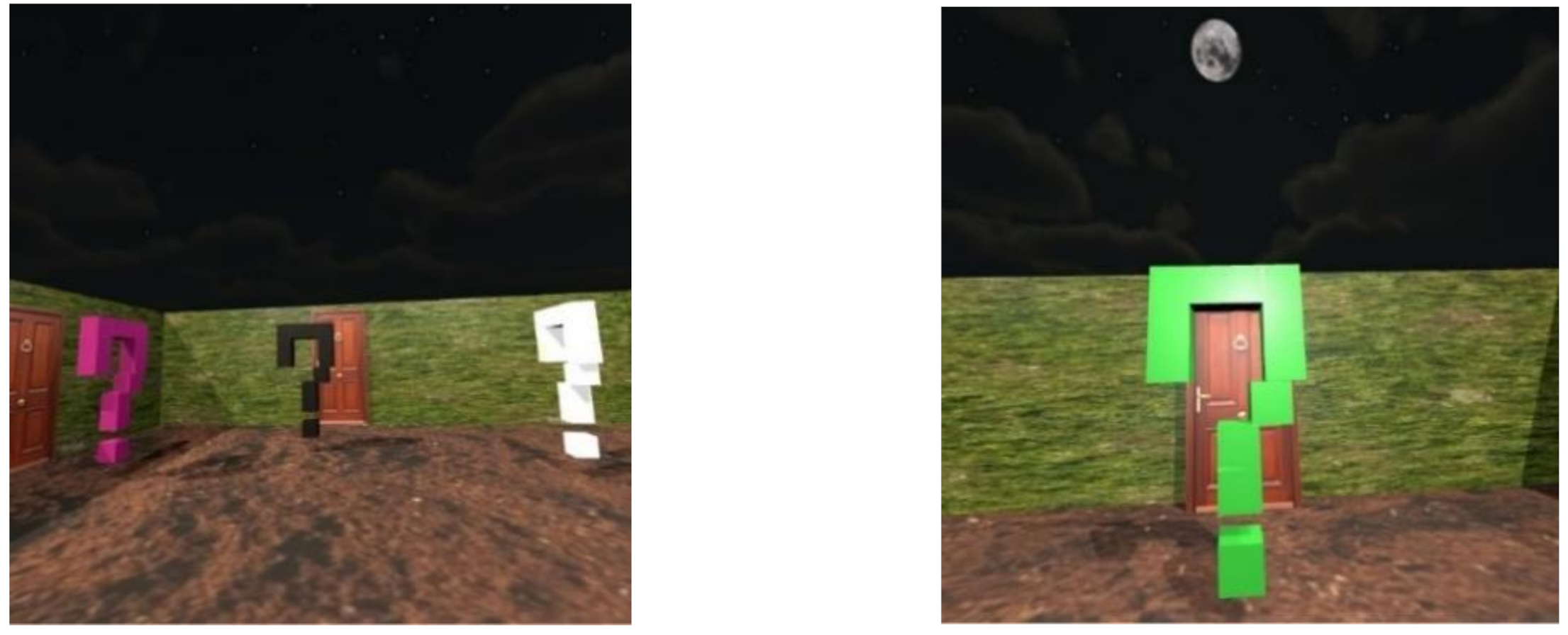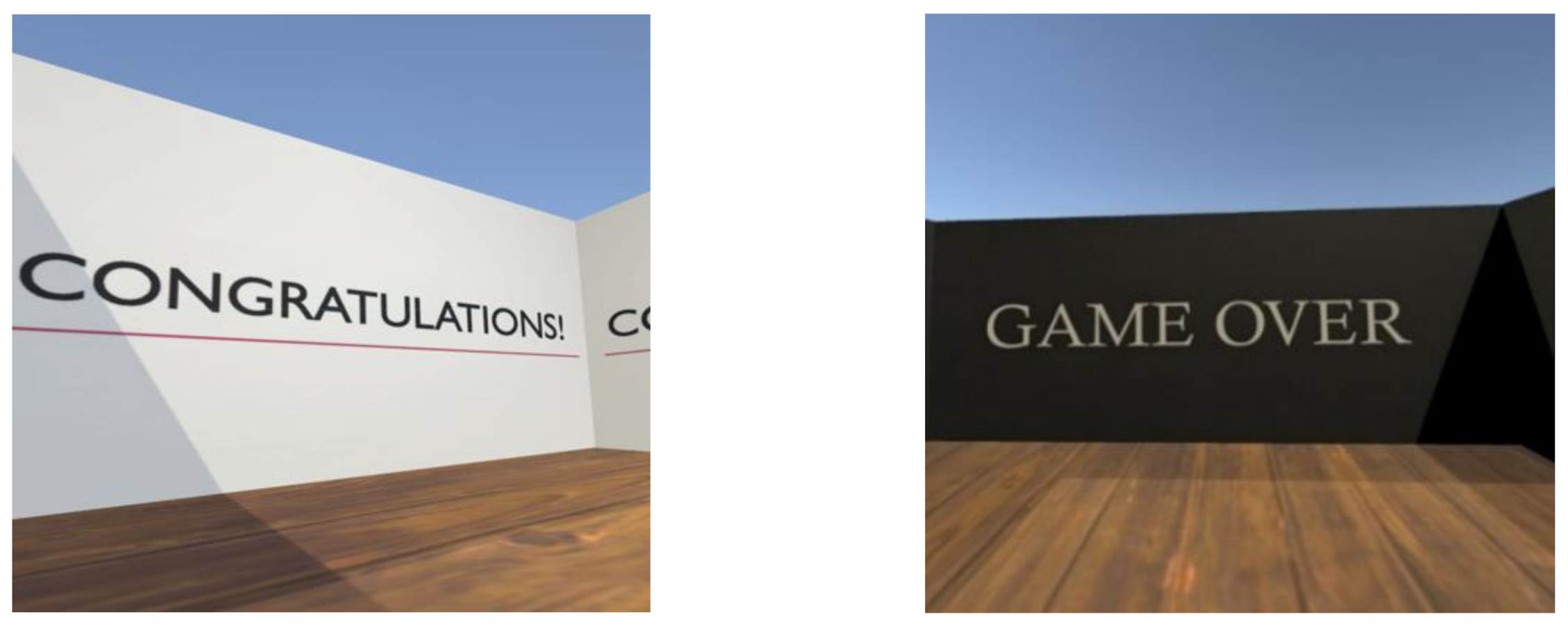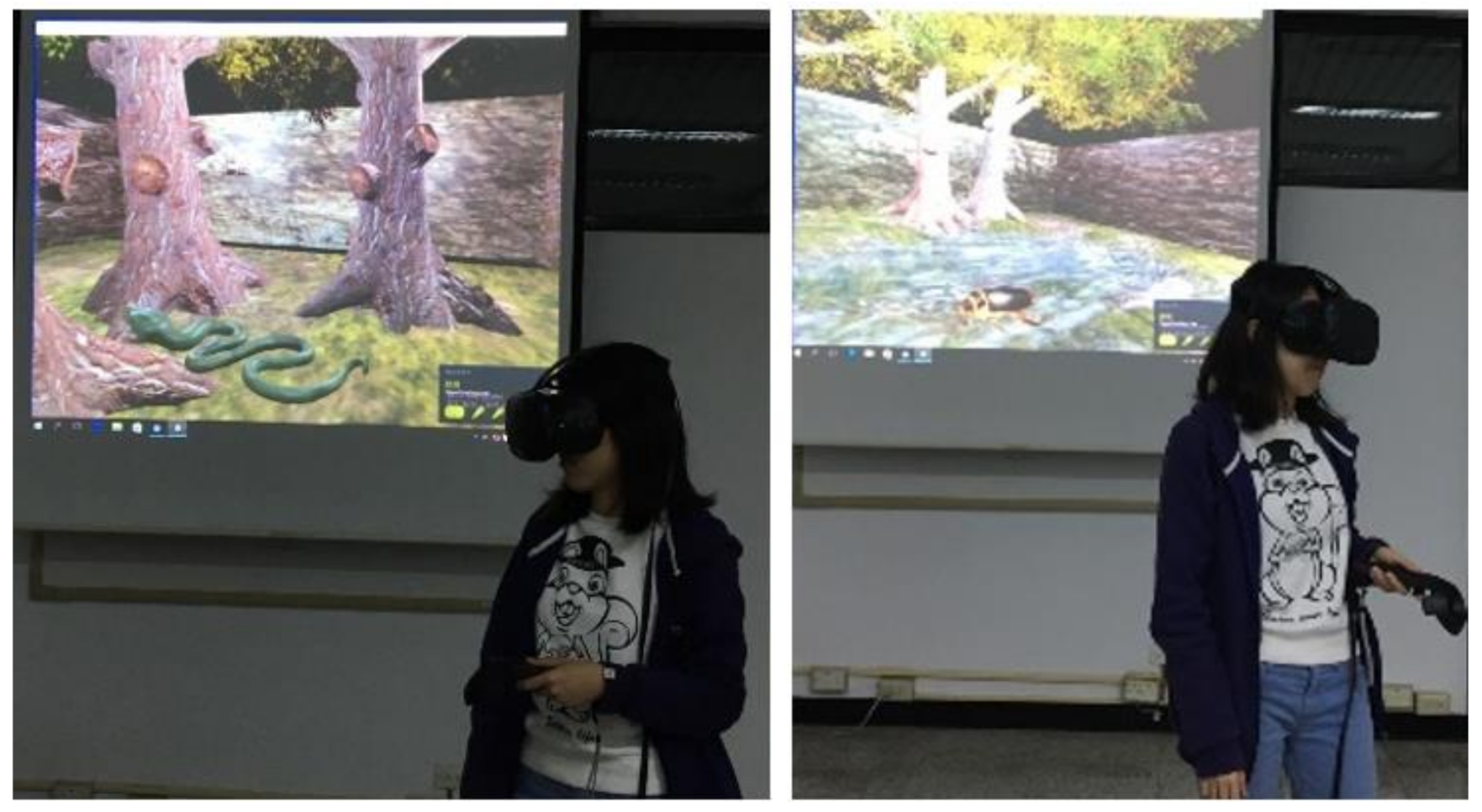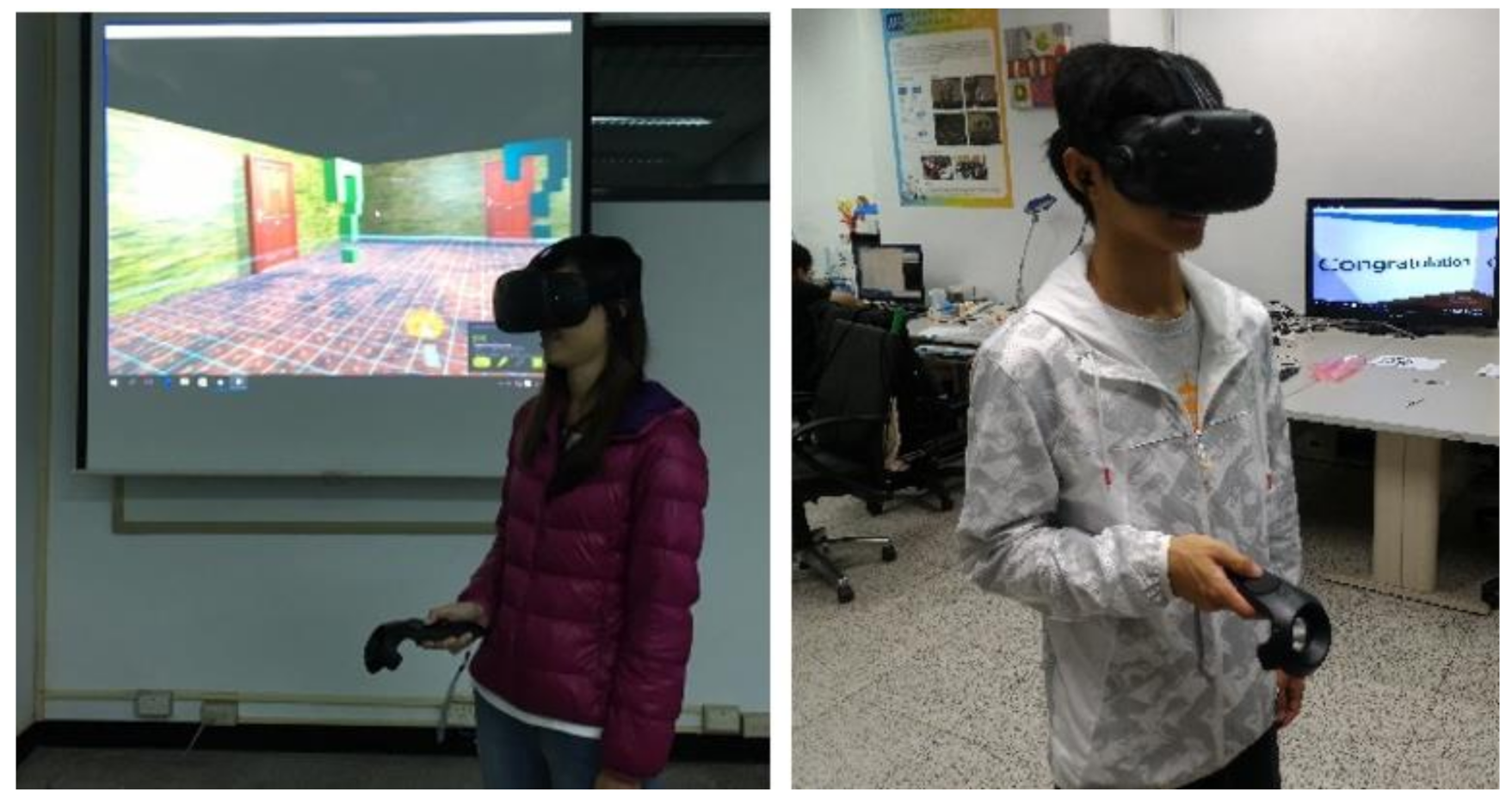1. Introduction
Environmental education is a topic characterized by a paradox. Very few people would doubt the importance of learning to live in a sustainable environment, but it receives not as much emphasis in school education around the world as suggested. The demand of environmental education indicates that human beings start to care about their living environments [
1]. Environmental education began in the 1960s, when the international community had begun to realize the importance of environmental conservation [
2]. Mankind discovered that excessive reliance on technology would lead to environmental damages, such as exhausting natural resources, destruction of ecosystems, and many other life-threatening situations. Therefore, schools began to conduct outdoor teaching activities with environmental education as the main issue. In the late 1960s, environmental education gradually transformed into the promotion of environmental conservation activities, and the legislation at that time required elementary and middle school students to learn about environmental protection and ecological conservation.
In the 1970s, the promotion of environmental conservation in many countries actively resolved environmental issues through the enactment of environmental protection laws and the training of conservation and education personnel. For example, the United Nations officially proposed the International Environmental Education Program in view of the fundamental assistance of education to the improvement of environmental problems [
3]. In Taiwan, the Ministry of Education (MOE) issued the “General Guidelines of Grades 1–9 Curriculum for Elementary and Junior High School Education” in 2003 [
4]. Among these guidelines, “Environmental Education” is an important topic and its far-reaching significance is the cultivation of sensitivity to environmental problems and the ability to solve these problems in addition to the understanding of basic concepts and knowledge. The purpose of environmental education is to guide the general public to participate in environmental protection activities and positively solve environmental and ecological problems that may occur in the future.
The objective of environmental education is to find out problems to establish the notion of sustainable development. For the young generation, creating sustainable ecological environments and restoring endangered species are worthy and directly useful learning topics. The goal is to realize the meaning of keeping a good relationship with living environments, understand the environmental issues in our society, and learn to improve our environments. Under the teacher’s guidance, students can become aware of the environmental problems and natural ecology. Finally, they can develop the skills of solving problems and thinking independently, establish environmental values, and participate in establishing and enhancing our living environments.
Environmental education aims at improving the experiences and skills of students in their surroundings by reflecting real life. After knowing the history and development of environmental education, students may understand the current situation and future trends of environmental protection. They can also understand the difference between ‘‘formal’’ and ‘‘social’’ environmental education from the definition, meaning, and knowledge categories. The main purpose of this study is to use the endangered species, the Taipei tree frog, as a role for students to experience and understand its ecological behavior and habitats through the virtual reality (VR) technology. The objective is to help them conduct situated learning in the virtual ecological environment supported by the role-playing game (RPG) to enhance their learning interesting and motivation.
The Taipei tree frog is a species of the family
Rhacophoridae, and it is indigenous to central and northern Taiwan. Its scientific name is
Rhacophorus taipeianus, and its common name is Taipei tree frog, published by Liang and Wang in 1978 [
5]. The Taipei tree frog is a small and medium-sized tree frog with a body length of four to six centimeters (
Figure 1). The basic characteristics of the Taipei tree frog are listed as follows:
The back is green and has a smooth texture without particles.
The abdomen is white with a little yellow.
The inside of the thigh is yellow with some black spots.
The color of the pupil of the eye is black, the shape is horizontal ellipse, and the color of the iris is yellow.
There are suction cups on the extremities, and the color of the suction cups is yellow.
The female frog is larger than the male frog.
From spring to early autumn, Taipei tree frogs live on trees or at the bottom of the forest. During the end of autumn and beginning of winter (the breeding period), the male frogs migrate to the still water near the forest and dig holes at the roots of the plants beside the water and the gaps between stones. Most Taipei tree frogs choose wet and soft soil as mating places on rainy nights and use the mud as a protective color. Female frogs lay eggs in wetlands next to aquatic plants or trees. During the process of laying eggs, they secrete foam to protect the eggs from sunlight and natural enemies. The color of eggs is white, and the number varies from 300 to 400 eggs, hatched in about one to two weeks. The tadpoles of the Taipei tree frog initially live in a small pond in the tree hole until the heavy rain washes them into the nearby waters.
This study integrated the VR technology with the knowledge of Taipei tree frog to develop a virtual ecological environment, and the goal was for learners to experience and understand its behavior and habitat and establish the concepts of environmental conservation. Students could learn about the ecological behavior of the Taipei tree frog by controlling perception and movement in the virtual environment. They could play the role of the Taipei tree frog in the forest and water ecological areas to forage, avoid natural enemies, and find the fallen leaves for nesting. Finally, they had to recognize the croaks of the Taipei tree frog to complete the mission.
2. Theoretic Framework
2.1. Gamificaiton and Situated Learning in VR
Virtual reality is the computer-generated simulation of a three-dimensional image or environment where one can interact with in a seemingly real or physical way using special computer interface, such as a helmet with a screen inside or gloves fitted with sensors. VR is a technology widely used in science, education, and training [
6]. Since the 1990s, studies have emphasized that VR allows learners to explore in an inaccessible place [
7] or unsafe environments in real life [
8,
9,
10]. Applications of VR in the classroom enabled students to learn and conduct scientific inquiries in a simulated environment [
11]. In addition, students in virtual learning environments reported higher learning interest and motivation [
12], and their learning achievements were also enhanced [
13].
VR systems can be categorized as low immersive, partially immersive, and fully immersive systems. The low immersive VR system often displays virtual objects in hand-held devices with small screens or desktop computers with a two-dimensional display monitor. This type of VR system has a problem displaying virtual objects due to having a restricted screen size, and the user can only interact with virtual objects using the mouse, keyboard, and touchscreen. For the partially immersive VR system, users have a full vision by wearing the head-mounted display (HMD), and they can interact with the virtual objects through the motion-sensing control. The HMD VR provides a better immersive experience than the desktop VR, but the heavy HMD equipment and VR motion sickness may affect the users’ acceptance. The last type of VR is the room-based VR system, where the users have a full vision without wearing the HMD and they can interact with virtual objects directly to achieve a fully immersive experience.
To enhance students’ learning effectiveness, gamification and situated learning theories are usually considered when implementing a VR-based learning environment. In gamification, teachers gamify a learning activity by including mechanisms such as game scores, levels, and experiences for mastering a given level of learning. Gamification has been an active area of study in recent years for increasing students’ interest in classrooms [
14]. Parra-González and Segura-Robles’s research indicated that gamification motivates students when facing complex problems and achieves high levels of activation and creativity [
15]. Serious games with interesting instructional design could enable players to engage in the learning activities for a longer time as reported in [
16].
It was discovered in [
17] that applying video games in teaching is effective for increasing cognitive development, motivation, and engagement. Papastergiou [
18] revealed that the gaming approach was both more effective in promoting students’ knowledge of computer memory concepts and more motivational than the non-gaming approach. Gamification enables learners to retrieve previous knowledge and experiences to enable higher level knowledge construction, and supplies immediate response to accomplish interaction with learners. In addition, the gaming approach helps learners to retrieve information from memory more easily to increase the learning effectiveness.
According to the situated learning theory, the presentation of knowledge should appear in a realistic situation and revolutionized according to social interaction and scientific verification to solve the problems and enhance cognitive and learning abilities by observing and interacting in a real environment. Bruner [
19] proposed that learning activities requiring creation and discovery could help learners develop a concept by induction and understand its meaning by applying previous knowledge. Brown et al. [
20] believed that learning must occur between learners and environments. In science education, the living environments are the foundations for learning and the real-life problems are the center for establishing knowledge. As a result, students are able to construct meaningful knowledge for applications in solving real-life problems.
Based on the above learning theories, a virtual ecological environment was developed in this study to help students integrate the knowledge collected in their surroundings with the teaching materials in order to familiarize themselves with the Taipei tree frog and realize the meaning of environmental education. From the perspectives of instructional design and learning methodology, the VR technology enables students to investigate and disclose new knowledge in their ecological environments, allowing them to know the value and significance of environmental protection.
2.2. Immersion Factors of VR
Dede [
9] surveyed several VR systems for applications in education and found that students’ learning motivation was enhanced when learning in an immersive media environment. Slater [
10] discovered that learning outcomes in virtual environments were affected by learners’ sense of immersion, a psychological state in which people perceive themselves to be enveloped by and interacting with an environment. A higher degree of immersion can usually increase learning achievements. The sense of immersion in a virtual environment is measured as “presence” in practice, which reflects the perceptual illusion of being in the place delivered by a virtual environment [
21,
22]. Several factors affect users’ presence in a virtual space, and a key factor is the user interface of the VR system [
23,
24]. Although the room-based VR provides the highest immersive experience, the cost and the space required is also the highest among the three types of VR systems. The desktop VR and HMD VR are becoming increasingly popular in the consumer market, and they are affordable for school teaching applications.
Anxiety represents inner troubles, sorrows, and restlessness, and it may also influence presence [
25,
26,
27]. Sometimes, anxiety is a negative emotion that produces an uncontrollable feeling, making an individual less optimistic about the future. When anxiety occurs, it is usually accompanied by a feeling of unreality that makes one want to escape [
28]. Nevertheless, anxiety may improve learning outcomes and behaviors [
29]. Moderate anxiety is helpful for learning, but excessive anxiety can cause psychological illness. When using a VR system, an appropriate level of anxiety is desirable. This study thus investigated the level of anxiety when learning in a virtual environment. In spatial learning environments, Srivastava et al. [
30] revealed that the learning performance using the desktop VR is better than that of using the HMD VR with a restricted area of movement. Sousa Santos et al. [
31] found that the interaction of HMD VR is more intuitive and natural. However, the impacts of presence and anxiety were seldom discussed.
Presence is defined as the subjective experience of an individual perceiving the existence in a place or feeling that other virtual individuals are also in the environment [
32]. In a virtual environment, presence refers to experiencing the virtual rather than the real environment [
21]. Users in a virtual environment with a high level of presence can also experience the same emotion in a real-life situation [
12], and their feelings in the environment are closely related to their emotional experiences [
24,
25]. The sense of presence is susceptible to one’s perception in an environment and its interaction with the individual [
33]. A person with a strong sense of presence can clearly feel he or she exists in the virtual environment and interacts with the virtual objects. This sense of presence naturally occurs when the user can walk, jump, or even move objects in a virtual environment [
34].
Several types of VR technologies have been used for learning and training purposes, with different levels of presence supported. For example, Williams-Bells et al. [
35] introduced using the desktop VR and serious games for firefighter training. The trainees in the virtual environments were safely involved in a simulated emergent situation that could be dangerous in real life. Makransky et al. [
36] compared the desktop VR and HMD VR for learning in a virtual science lab. The results indicated that learners in the HMD VR were more immersed in the learning situation and reported higher presence than learners in the desktop VR. When learners were immersed in a virtual learning environment, accelerated cognition, increased attention, and improved critical thinking had been reported [
37,
38,
39]. Therefore, learning outcomes in student-centered VR approaches are superior to those of traditional teacher-centered approaches. However, the effects of immersion on learning outcomes are controversial [
40].
An immersive VR system enables users to feel the environment, and the sense of presence is proportional to the degree of immersion and interaction between the individual and the environment. This supports researchers to conduct clinical studies using VR as a tool to observe psychological behavior. For example, Peperkorn et al. [
41] presented large spiders in a VR environment where presence seemed to be a direct influence, and they appeared to be mutually dependent. Nolin et al. [
42] built a virtual classroom to examine school children’s attention and analyze the relationship between presence and learning achievements. Parong and Mayer [
43] compared three types of VR displays and the results supported the cognitive theory of multimedia learning and demonstrated the value of creative learning strategies in immersive VR environments.
Some studies of virtual reality exposure therapy (VRET) indicated that a high level of presence may affect the level of anxiety. For example, Morina et al. [
44], Ling et al. [
45], and Yeh et al. [
46] assessed the anxiety of participants by measuring skin conductance and heart rates when entering a virtual scene and a significant difference in anxiety was observed. Aside from VRET, research has revealed that VR may reduce anxiety. For example, Kwon et al. [
47] studied the influence of anxiety in a virtual environment simulating the job interview scenario. The results indicated that the sense of anxiety was less correlated with graphical realism in the virtual environment, although the virtual human detailed more graphically could provoke a higher level of presence.
2.3. Applications of VR in Environmental Education
Fan et al. [
48] proposed a simulated ecosystem to investigate students’ attitudes towards virtual educational environments. The statistic results showed that the application of virtual reality could raise educational quality and solve existing problems on environmental education. A campus butterfly garden is a useful teaching resource for studying insect ecology, but it requires professional construction and maintenance for sustainable development. Tarng et al. [
49] developed a virtual butterfly ecological system combining campus host plants and virtual breeding activities using the mobile learning technology, and the experimental results showed that using the virtual butterfly ecological system could increase the learning motivation and interest as well as learning effectiveness through virtual breeding and observation activities.
Designing learning activities for environmental education is challenging because they often take place in informal settings and outdoors. Ducasse [
50] discussed the potential of augmented reality (AR) for outdoor environmental education by giving a brief overview of learning theories and some examples of AR mobile apps for environmental education. Schneider and Schaal [
51] assessed whether smartphone games were suitable for fostering connectedness to nature and the differences between a complex Geogame and a less-demanding treasure hunt. The results revealed a significant increase in the inclusion of nature for both game formats, and the main effect in the disposition connecting to nature was the location-based activity in nature guided by smartphones.
This study combined the VR technology with the knowledge of the Taipei tree frog to develop a virtual ecological environment, and the purpose was for learners to experience and understand its behavior and habitat and establish the concepts of environmental conservation. Students could learn about the Taipei tree frog by controlling the perception and movement in the virtual environment. They could play the role of the Taipei tree frog in the forest ecological area and water ecological area to forage, avoid natural enemies, and find the fallen leaves for nesting. Finally, they had to recognize the croaks of the Taipei tree frog to complete the mission.
The question of whether the immersive VR is an effective learning technology still remains controversial. Therefore, this study used two types of VR interface, i.e., the desktop VR and the HMD VR, in the virtual ecological system to compare learners’ performance. A teaching experiment was performed in this study to investigate their learning achievements about the knowledge of Taipei tree frog and the senses of presence and anxiety after using the virtual ecological system. Statistical analyses were performed based on the achievement tests and questionnaire results. According to the research purpose of this study, the research questions are listed as follows:
- (1)
Is there a significant difference in the level of presence between the students using the desktop VR and the HMD VR?
- (2)
Is there a significant difference in the level of anxiety between the students using the desktop VR and the HMD VR?
- (3)
Is there a significant difference in learning achievements between the students using the desktop VR and the HMD VR?
3. Virtual Ecological System
In this study, a virtual ecological system containing knowledge of Taipei tree frog was developed based on the pedagogical theories of situated learning and game-based learning. The learning contents was analyzed first and then the system was developed based on the learning objectives. Since situated learning emphasizes realistic learning activities, a connection to forest ecology and water ecology was emphasized to provide learners with skills and experiences similar to real-life situations. Additionally, a role-playing game was designed for learners to play the role of Taipei tree frog and complete the missions in the forest and water ecological environments.
3.1. Pedagogical Theories
This study used the pedagogical theories of game-based learning and situated learning to enhance the students’ learning interest and motivation. The game-based learning approach designed the instructional activity by integrating interesting games into teaching for instructional goals. In this study, the role-playing game and many tasks have been developed to enhance the interest and motivation for learning the Taipei tree frog and its ecological behavior. They could explore in the missions of foraging and avoiding natural enemies when playing the RPG to become familiar with the relationship between consumers and producers in the food chain of the ecological areas.
The situated learning approach presented the knowledge of the Taipei tree frog in a virtual scene according to different ecological situations, e.g., the forest and water ecological environments. Students could observe and interact in the simulated environment for cognition when performing a mission, e.g., foraging, avoiding natural enemies, and identifying frog croaks, to increase their learning interest and motivation. The game missions allowed them to enjoy the challenge, discover the problems, and complete the missions. By conducting these learning activities, they could obtain the practical experiences and useful knowledge of the Taipei tree frog for applications in the real world. Through the game-based learning and situated learning approaches, the instructional goals were achieved more easily to improve learners’ abilities.
To understand how the desktop VR and HMD VR user interfaces affect levels of presence and anxiety as well as learning the achievement, a teaching experiment was conducted using the virtual ecological system for learning the Taipei tree frog, a species that is endangered because of wetland destruction and extensive use of pesticide. The virtual ecological system can save the time and effort of travelling to the natural habitat for observing the Taipei tree frog, and the design of role-playing game can enhance learners’ interest and motivation. Additionally, a frog croak area is designed for learners to recognize the croaks of the Taipei tree frog under different situations. Therefore, it is a useful tool for promoting environmental education and ecological conservation.
Figure 2 shows the research structure of the virtual ecological system.
3.2. Practical Aspects
In this study, the user interface of the virtual ecological system was designed using the C# programs in the Unity3D, a 2D/3D cross-platform game engine developed by Unity Technologies. It is mainly used to design games for the platforms of Windows, MacOS, Linux, iOS, and Android. In addition to the development of games, the Unity3D is often used in architectural visualization, 3D interactive simulation, and comprehensive creation tools. The procedure for developing the virtual ecological system includes designing the virtual scenes, texture images, 3D models, and motions of the Taipei tree frog, insects, and predators (snakes and spiders).
Figure 3 shows the design of virtual scene and the model of Taipei tree frog using Unity3D and 3ds Max.
In order to simulate the motion of the Taipei tree frog and insects in the virtual scenes, their dynamic features were analyzed based on the recorded video. Then, a number of motions were chosen for every insect to simulate its behavior.
Figure 4 shows the three sets of motions for the dragonfly to fly, tap tail, and rest in the virtual scene, and each motion is divided into a number of segments. The same attitude is used in the initial and final positions of the sequence to prevent discontinuity of different motions during transformation. The motion is set to take place at the same position in the virtual scene, and the rotation and displacement are computed by the C# programs in Unity3D.
The hardware used in this study included the HTC VIVE and the computer for running the VR software, which is developed by this study. The user could interact with the virtual objects using the controller for interaction. The minimum system requirements for the HTC VIVE listed on the official website are shown below:
GPU: NVIDIA® GeForce® GTX 970, AMD Radeon™ R9 290 or above;
CPU: Intel® Core™ i5-4590/AMD FX™ 8350 or above;
OS: Windows® 7 SP1, Windows® 8.1 and Windows® 10 with RAN: 4GB or above.
The time required for developing the virtual scenes and 3D models, including the dynamic motions, is about four to six months, depending on the designer’s proficiency in Unity3D and 3ds Max. The cost of the HMD, including the controller, is about $500 to $800, and the computer with the required CPU and graphics card may cost $1500 or more. As we can see, it is not easy for the general teachers to develop the VR system by themselves. The cost of the required equipment for the virtual ecological system is more than $2000, which is a little too expensive for students and thus unfavorable for promotion.
3.3. Exhibition Hall
The exhibition hall is designed based on the knowledge of Taipei tree frog, including different stages of its life cycle (egg, tadpole, tadpole with legs, froglet, and adult), ecological behavior (foraging and mating), and habitat. The user’s mission in the exhibition hall is to learn knowledge from the pictures and texts on the wall.
Figure 5a shows the image on the screen of the desktop VR, and
Figure 5b shows the stereo image pair displayed on the HMD VR. The control group can use the keyboard and mouse, while the experimental group can use the headset to control the perspective and moving directions in the exhibition hall.
There are two ways for the user to move in the virtual environment when wearing the HMD VR. The user can simply walk in the real environment and the VR system will produce the corresponding visual effects according to the movement. If the virtual space is larger than the real space, the user can set the virtual target for an instant movement by pressing the touch pad button on the controller and pointing it to the target on the ground. The user will then be transferred to the position in the virtual space where he or she points to. For example, after watching the pictures and texts on the wall of the exhibition hall, the user can move from the current position to the central exhibition cabinet by setting the virtual target for an instant movement (
Figure 6).
3.4. Forest Ecology
In the forest ecological area, the learner’s mission is to play the role of Taipei tree frog in the virtual environment to forage, avoid natural enemies, and migrate to nearby waters. The variables in the role-playing game include parameters such as health, hunger, and humidity. When the player, i.e., the Taipei tree frog, collides with the natural enemies, the health value is reduced, and it can be increased by catching an insect (foraging). In the forest ecological area, the natural enemies of the Taipei tree frog are snakes and spiders, and the foraging targets include small damselflies, small dragonflies, ants, and flies (
Figure 7). As time goes by, the skin humidity is reduced gradually if the tree frog is out of water for a long time. Failure to prey on insects or frequent contact with natural enemies will cause the tree frog to die and the game to end. After that, the player can choose to go back to the exhibition hall or try again in this scene.
3.5. Water Ecology
In the water ecological area, the learner’s mission is to play the role of Taipei tree frog in the virtual environment to forage, avoid natural enemies, and find the fallen leaves for nesting. When the player, i.e., the Taipei tree frog, sees an insect, he or she can get close to the prey and move around it for hunting. If the hunting is successful, there will be feedback of pictures and sounds and the hunger value will decrease while the experience value will increase. In the water ecological area, the Taipei tree frog will build a nest under the fallen leaves. Therefore, the player must find the fallen leaves to build a nest as a mating place. After that, the player can switch to the croak area to conduct the croak recognition of mating frogs. The natural enemies of the Taipei tree frog in the water ecological area are the same as those in the forest ecological area (
Figure 8a), but the foraging targets are different, including wigglers, water striders, water bugs, and dragon lice (
Figure 8b).
3.6. Frog Croak Area
In the frog croak area, the learner can see six question marks of different colors; each question mark plays the croak of a tree frog species as the learner approaches (
Figure 9). When the learner gets close to a question mark, a picture of a certain tree frog species shows up. The learner must determine if the frog croak belongs to the Taipei tree frog in the previous scenes (the forest ecological area and the water ecological area). The learner can walk through the door behind the question mark when deciding the cloak belongs to the Taipei tree frog. The screen shows “Congratulations” or “Game Over”, depending on the correctness of the decision (
Figure 10).
A formative evaluation was conducted after the design of the virtual ecological environment was completed to verify if it could meet the instructional goals and the user’s expectation. In practice, the evaluation can be conducted during any phase of the ADDIE process [
52], an instructional system design framework often used by instructional designers when developing learning systems and courses. There are five phases defined in the ADDIE process for building learning systems and training support tools, i.e., analysis, design, development, implementation, and evaluation.
In this study, the formative evaluation was focused on the development and implementation phases of the ADDIE process to ensure the user interface, learning contents, and gamification of the virtual ecological system could satisfy the instructional goal and learners’ expectations. It was a technology acceptance model questionnaire containing 15 questions, designed to investigate if the user was satisfied with the learning contents, user interface, and gamification of the system. The samples conducting the questionnaire survey were 40 undergraduate students in a university in northern Taiwan, and the Cronbach’s alpha is calculated as α = 0.81, indicating the collected data were reliable. The average score of the questionnaire results was 4.09, showing a high degree of acceptance for the virtual ecological system. According to the questionnaire results, the users believed that the virtual ecological system was helpful for learning the knowledge of the Taipei tree frog. They thought the learning contents were easy to understand and the user interface was easy to operate. They considered the system highly realistic and entertaining. The feedback could be reviewed to improve the VR system.
4. Teaching Experiment
A teaching experiment was performed in this study to explore the learning performance of the virtual ecological environment and the levels of anxiety and presence when using the system. This study used the quasi-experimental design to compare the difference in learning effectiveness between the HMD VR group and the desktop VR group. The experimental samples were mainly undergraduate students recruited from a university in northern Taiwan, and they were randomly divided into two groups. The experimental group (using the HMD VR) and the control group (using the desktop VR), containing 40 students in each group, were used as samples to participate in the learning activity about the Taipei tree frog using the virtual ecological system. Both groups completed the pre-test about the Taipei tree frog before the learning activity. After learning with the virtual ecological system, they took the post-test and conducted the questionnaire survey for measuring the senses of anxiety and presence. The following describes the research tools, experimental variables, and analytical results.
The achievement test contained a number of 23 multiple-choice questions to evaluate the knowledge of Taipei tree frog in the areas of its characteristics (1 question), prey and natural enemies (1 question), egg stage (2 questions), tadpole stage (5 questions), habitat (5 questions), mating (5 questions), and living environment (4 questions). It was designed as the pre-test and post-test, and the purpose was to investigate if the learners could improve their learning achievements through the VR learning activity and whether there was a significant difference in the learning effectiveness between the experimental group and the control group. The achievement test was revised according to the suggestion of a natural-science expert to ensure validity of its content.
Two questionnaire surveys were conducted to measure the levels of presence and anxiety when using the VR system. A five-point Likert scale [
53] was used in the questionnaire (strongly agree: 5 points; agree: 4 points; neutral: 3 points; disagree: 2 points; strongly disagree: 1 point). This study referred to the Igroup Presence Questionnaire (IPQ) [
54] for the construction of the presence scale (10 questions), which was used to explore the sense of presence in the VR system. The anxiety questionnaire (20 questions) was designed with reference to the guide for therapists in management of anxiety [
55].
The experimental group and the control group performed the achievement test before and after the learning activity to investigate the difference in learning effectiveness. The dependent variable was the post-test score, and the covariate was the pre-test score. The independent variable was the VR user interface, i.e., the experimental group used the HMD VR and the control group used the desktop VR. To reduce the interference of other factors, the instructor, learning contents, and learning time were listed as the control variables.
4.1. Level of Presence
In this study, the difference in the level of presence between the two groups is analyzed using the questionnaire results. The Cronbach’s alpha for all questions is calculated as α = 0.73, indicating the collected data are reliable. To determine whether a significant difference exists between the HMD VR group and the desktop VR group, an analysis of variance (ANOVA) is conducted and the results are shown in
Table 1.
The results in
Table 2 indicate both groups believed that the virtual environments created by the HMD and desktop computer provided a feeling of immersion, but the HMD VR group had the sense of presence higher than that of the desktop VR group (the significance
p =
0.001). An ANOVA is performed for each question to reveal more in-depth results. Among them, half of the questions achieved a significance of
p < 0.001.
4.2. Level of Anxiety
In this study, the difference in the level of anxiety between the two groups is analyzed using the questionnaire results. The Cronbach’s alpha for all questions is calculated as α = 0.90, confirming the collected data are reliable. There were 20 questions about whether the VR ecological system caused anxiety and if the anxiety was due to 3D glasses. To determine if a significant difference exists between the HMD VR group and the desktop VR group, an ANOVA is conducted and the results are shown in
Table 3.
The results in
Table 4 indicate that both groups considered the VR environments created by the HMD and the desktop computer caused low levels of anxiety. An ANOVA was performed on each question to investigate more in-depth results. The HMD VR group had more visual deprivation and they could walk freely in the environment that the participants had never walked in before, which might have caused higher anxiety. It can be seen from
Table 4 that the level of anxiety in each question of the HMD VR group is slightly higher than that of the desktop VR group. Apart from this, the results indicate no significant difference in the level of anxiety between the two groups.
4.3. Learning Effectiveness
To investigate if learners made significant progress after using the VR system, this study used the paired sample t-test to analyze the pre-test and post-test scores for both groups. For the experimental group, the significance
p < 0.001, showing the HMD VR could effectively improve the learning achievement. For the control group, the significance
p < 0.001, indicating the desktop VR could also improve the learning achievement. To compare the effectiveness of these two user interfaces, the analysis of covariance (ANCOVA) was used to analyze whether a significant difference existed in the learning effectiveness between the HMD VR group and the desktop VR group. The HMD VR group progressed from 48.50 to 73.00, and the desktop VR group progressed from 39.20 to 63.60 (
Table 5). After excluding the effect of the covariance on the dependent variable, the impact of independent variable on the learning effectiveness was calculated as
p =
0.02 < 0.05, showing a significant difference exists between the two groups. As a result, the HMD VR could improve the learning achievement more effectively than the desktop VR.
5. Observation and Discussion
In this study, the learning activities were conducted in the virtual scenes including the exhibition hall, forest ecological area, water ecological area, and frog croak area. The learning activity started with the exhibition hall after introducing the operation method and the mission in each area by the instructor. When the experimental group put on the head-mounted display, they hesitated because they could not adapt to the virtual environment for the first time, but it only took a minute or two for them to get used to it. However, the control group did not have this phenomenon, but the operation was not as fluent as that of the experimental group in controlling the virtual objects.
Figure 11 shows the experimental group learner (left) and the control group learner (right) in the exhibition hall. Most learners were concentrated on browsing the images and texts about the Taipei tree frog on the wall, and some learners reflected that the background music might attract or affect their attention. The learning contents in the exhibition hall include the pictures of the Taipei tree frog and its natural habitats as well as the texts describing its life cycle and ecological behavior such as foraging, mating, and nesting.
In the forest and water ecological areas, it was found that some learners were afraid of the insects and predators (snakes and spiders), which could affect the progress of the game although they could still complete the mission in the end. Both the experimental group and the control group had the same situations, but the responses were different. The reaction of the control group was mild, but the experimental group was more engaged in the virtual scenes and the response of dodging and flinching could often be seen.
Figure 12 shows the experimental group learner encountering a snake (left) in the forest area and trying to catch an insect (right) in the water area. The learners of the experimental group were used for instant movement using the virtual target, i.e., they could move without hesitation, but the perception of direction and space could be confusing because no movement was taken in the real world.
In the frog croak area, most learners could recognize the croaks of the Taipei tree frog according to the memory of background sounds in the previous scenes. However, some learners in both groups were too concentrated in the game missions in the previous scenes and ignored the background sounds such that they could not distinguish between the croak of the Taipei tree frog and that of other frog species. Therefore, some of the learners suggested that the croak should be connected with the appearance of the Taipei tree frog in the virtual scenes to reduce the distraction by the game missions.
Figure 13 shows the experimental group learner listening to the frog croak (left) and the mission completed when the selection of the frog croak was correct (right).
6. Conclusions
Environmental education helps people to explore all problems related to the current situation and future prospects of the natural environment and engage in wise ways to preserve it. The purpose is to discover and resolve surrounding problems to establish the notion of sustainable development. The VR technology was used in this study to design a simulated environment for learning the ecological behavior and natural habitats of the Taipei tree frog. Two types of VR user interfaces, i.e., the desktop VR and the HMD VR, were designed for learners to play the role of the Taipei tree frog in foraging, mating, nesting, and avoiding natural enemies. The learners could fully participate in the Taipei tree frog’s ecological environment to acquire a deeper understanding of its natural habitat. A teaching experiment was conducted to investigate students’ learning effectiveness and senses of presence and anxiety after using the virtual ecological environment.
6.1. Comparison to Previous Studies
According to the experimental results, learners in both groups made significant progress in learning the knowledge of Taipei tree frog after using the VR system, indicating both the desktop VR and the HMD VR could enhance their learning achievements. However, a significant difference was found between the two groups, and the experimental group performed better than the control group, indicating the HMD VR was more effective than the desktop VR because the sense of immersion created by the former is higher than that by the latter. The results are same as those reported in [
37,
38,
39], showing that learners had better cognition, attention, and critical thinking in an immersive virtual environment. Therefore, this study provided evidence to clarify the controversy regarding the effects of immersion on learning outcomes [
40].
The questionnaire results indicated a significant difference in presence level between the two groups. The level of presence for the experimental group was higher than that of the control group because the HMD VR provided a more immersive experience than the desktop VR. The results were similar to those obtained in [
36], and they also supported the findings in [
33,
34] because the experimental group could clearly feel their existence in the virtual environment and interact with the virtual objects. The sense of presence naturally occurred because they could play the role of the Taipei tree frog to avoid natural enemies and forage insects in the virtual ecological environment.
However, there was no significant difference in the level of anxiety between the two groups, and the virtual environment caused a low level of anxiety, less than 2.5 for each question. Therefore, learning about the Taipei tree frog using the virtual ecological environment can reduce the level of anxiety. The observation results revealed that the stereo visualization and the sense of presence for the HMD VR group provided immersive learning situations for students to explore in the virtual scenes to increase their cognition when playing the role of the Taipei tree frog. They could also observe from different angles and positions to acquire useful experience and knowledge. Thus, using the VR technology for instructional design conformed to the situated learning and game-based learning theories, and therefore the ability of solving problems could be improved.
Aside from the experimental results, the virtual ecological system is advantageous to traditional teaching methods. Firstly, abundant learning contents are provided to save the effort and expense in instructional preparation. Secondly, the learning activity can be conducted at home and thus the VR ecological system is suitable for promoting environmental education. Thirdly, the teaching activities for natural science in school education are mainly observing animals and plants often seen in our surroundings, and the VR system offers a simple and effective tool for observing wildlife in remote or restricted areas. The VR ecological system can solve the problem of being unable to visit real ecological environments and avoid disturbing the Taipei tree frog or destructing its habitat. Furthermore, the interactive learning situations and interesting missions in the virtual ecological environment can transform abstract knowledge to concrete experiences and thus supplement the insufficiency of environmental education in school teaching.
Virtual reality can be applied in subjects that may cause anxiety or fear, for example, walking the balance beam in physical education, to prevent learners from accidentally falling and getting hurt. It can also be applied in anatomy experiments that may cause learners to feel nauseated and anxious, or chemical experiments that are highly dangerous, in which learners often feel nervous because they are afraid of making a mistake. Teaching in virtual environments can reduce learners’ anxiety. For example, the HMD allows learners to walk into the natural environment by extending the spatiality and observability. However, there exist some differences between the virtual and real environments. For example, VR can be used to simulate 3D visual effects, but it is difficult to simulate the senses of smell and touch. Additionally, in order to avoid affecting the eyesight or suffering from motion sickness, the recommended use time of the HMD VR is 30 min, and it is only suitable for users over the age of twelve. The application of VR in education is not limited by time or space, and it can increase the students’ learning interest and motivation, so it is a suitable tool for the promotion of environmental education.
6.2. Limitation and Future Works
Despite its various applications and increasing popularity, VR still has some drawbacks and limitations. For example, the cost of VR devices is still high. In this study, the HTC VIVE, including a VR headset and a controller, was used, and its cost was around $600. Besides, the VR software takes up a lot of memory space, and it requires more computing power so that the user needs a computer with powerful CPU and graphics card to execute the VR software. In addition, the heavy HMD and the VR motion sickness may affect the willingness of using the VR software. When the user puts on a VR device, he or she cannot see the surroundings and the lack of vision may cause an accident.
The learning model of the virtual ecological system can be applied to other courses, and our future works include the extension of VR applications to:
VR wetland ecological system: the VR system can be designed using VR360 technology to display the real wetland environment. Students can wear a VR cardboard to complete the exploring missions and challenging stages to learn about the wetland creatures and understand the importance of the wetland environment.
VR experimental systems: students can build an electric circuit using the VR circuit system to measure the voltage and current through a light bulb, batteries, and wires for the cases of parallel and serial connection. They can also use the convex and concave lens in the VR optical system to observe the images formed on the screen by adjusting the distance of an object inside or outside the focal length.


